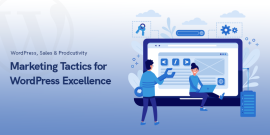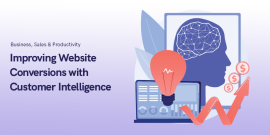
The Role of IT in Shaping the Future of Social Media Platforms for Social Media Marketing
Table of Contents
ToggleSocial media platforms have gone through a tremendous evolution, transforming how people communicate, share information, and connect globally.
The early stages of social media are the early days of the internet, with platforms like Six Degree created in 1997 allowing users to create profiles and connect with others.
The mid-2000s witnessed the rise of platforms like Friendster and MySpace, laying the foundation for the more recognized platforms that are known today.
Finally, in 2004, Mark Zuckerberg and his co-founders launched Facebook, introducing a revolutionary concept of connecting friends online. Twitter, followed in 2006, concentrated on real-time microblogging.
Leading Instagram (2010) and Snapchat (2011) appeared, strongly emphasizing visual content and short and disappearing messaging in Snapchat's case.
Social media marketing is one of the most popular marketing techniques these days. Every brand with an online presence is also on social media.
But, not everyone is equally successful at social media marketing.
So, what can you do to ace your social media marketing game?
Well, that’s what this post is all about.
The evolution continued with the rise of professional networking platforms like LinkedIn, the visual discovery platform Pinterest, and the video-sharing giant YouTube.
The most recent trends include the surge of short-form video content on platforms like TikTok.
IT encourages continuous innovation in social media platforms, introducing new features and functionalities to meet user demands.
IT Innovations in Social Media
The progression of AI and machine learning has greatly impacted social media, specifically in content recommendations. AI algorithms, including advanced text generators, automate content creation and recommendations in the following ways:
Personalized Content Recommendations:
AI analyzes user behavior to offer personalized content recommendations, ensuring a more tailored and engaging user experience.
Automated Content Creation:
The AI text generator automates content creation, generating human-like text for captions, comments, and posts, saving users time and ensuring consistent content flow.
Moreover, there are other innovative AI tools that can help with campaign implementation during social media holiday calendar planning. These visual content creation tools, like an animated logo maker, can improve the company's branding and fit the business's target audience.
Natural Language Processing (NLP) for Context:
NLP models improve content recommendations by understanding context and aligning suggestions with user reactions and current topics.
Enhanced User Engagement:
AI-driven recommendations lead to increased user engagement, predicting preferences for longer sessions and higher interaction levels.
Continuous Improvement of Algorithms:
AI algorithms continuously learn and improve content recommendations based on user interactions and feedback, ensuring ongoing optimization.
The Impact of IT on User Experience
Personalization and customization features
IT has transformed user experience on digital platforms, particularly by implementing personalization and customization features.
-
User-Centric Design:
IT allows platforms to gather and analyze user data, allowing for the development of user-centric design approaches.
Personalization features, driven by algorithms and machine learning, enable platforms to understand individual preferences, behavior, and demographics. Additionally, with the help of an AI ad maker, the creation of ads became better structured and personalized.
-
Personalized Content Delivery:
Based on user preferences and history, personalized recommendations improve the relevance of content delivered to users.
Customized content feeds, product recommendations, and user interfaces create a more unique experience, increasing user satisfaction.
-
Adaptive User Interfaces:
IT enables the development of adaptive interfaces that adjust based on user interactions and preferences.
Features such as customizable layouts, themes, and settings empower users to personalize their digital environment according to their preferences.
-
Predictive Analytics:
IT-driven analytics predict user needs and behaviors, enabling platforms to offer personalized suggestions and solutions.
This predictive capability enhances user satisfaction by providing relevant information before users explicitly request it.
-
Real-time interactions and engagement:
Real-time interactions and engagement are crucial aspects of user experience that IT has significantly influenced. Mobile push marketing is a key component contributing to personalized and real-time user experiences:
Mobile Push Marketing:
It enables platforms to send targeted and personalized notifications directly to users' mobile devices.
These notifications can include personalized offers, updates, and relevant content, enabling immediate engagement and interaction.
-
Timely and Relevant Alerts:
Mobile push notifications, powered by IT, deliver timely and relevant alerts to users, keeping them informed about new messages, updates, or events.
This real-time communication improves user engagement by providing instant access to important information.
Challenges and Concerns
Data privacy issues and security considerations:
The increasing volume of user data collected by social media platforms leads to a risk of data theft and cyberattacks.
Security vulnerabilities may lead to unauthorized access and abuse of personal information, compromising user privacy. Considering this, continuous concerns arise regarding the transparency of data collection practices and the level of user consent. Moreover, users may be unaware of the extent to which their data is being utilized.
Social media platforms operate globally, making it challenging to comply with diverse data protection regulations.
Keeping a balance between providing personalized experiences and being cautious of regional privacy laws poses a complex challenge for platform operators.
Ethical implications of AI-driven algorithms:
The complexity of AI algorithms, especially in the context of social media, can result in a lack of transparency.
Users may be unaware of how algorithms influence the content they see, raising concerns about accountability and the potential for unintentional consequences.
Manipulation and Filter Bubbles:
AI-driven algorithms may contribute to the creation of filter bubbles, where users are exposed to information that aligns with their existing beliefs, limiting diverse perspectives.
This raises ethical questions about the impact of algorithms on the democratic exchange of ideas and information.
Striking a balance between innovation and user protection:
Balancing innovation with user protection involves providing users with greater control over their data and online experiences.
Empowering users to manage privacy settings and preferences contributes to a more ethical and user-centric approach.
Establishing clear industry standards and complying with regulations is vital for navigating the delicate balance between innovation and user protection.
Continuous Monitoring and Adaptation:
Social media platforms must continuously monitor the evolving landscape of technology, user expectations, and ethical considerations.
Regular assessments and adaptations to policies, algorithms, and features are necessary to address emerging challenges and balance innovation and user protection.
Future Trends
Enhanced Personalization Algorithms
AI will be increasingly critical in refining personalization algorithms, considering a broader range of user data and behaviors to provide even more accurate and personalized experiences.
Context-Aware Recommendations
Future AI systems will focus on understanding contextual cues, including factors like real-time location, user mood, and situational context, to deliver hyper-personalized content recommendations.
Predictive User Experiences
AI will develop further to predict user needs and actions more accurately, providing proactive user experiences that go beyond simple content recommendations.
Immersive Technologies
Augmented Reality (AR) and Virtual Reality (VR) may become integral to social media, transforming user interfaces into immersive experiences and allowing users to interact with content in three-dimensional spaces.
Voice and Gesture Control
User interfaces will shift towards more intuitive controls, with the integration of voice and gesture recognition technologies, allowing users to interact with social media platforms in a hands-free manner.
Minimalistic and Adaptive Designs
Future user interfaces will prioritize minimalistic designs and adaptive layouts, providing a clean and personalized visual experience that adjusts to individual user preferences and device capabilities.
Recommendations
Transparency and User Education
Social media platforms should provide clear and accessible information about how IT is used for data collection, algorithms, and content recommendations. Users should be educated on the given control over their privacy settings.
Ethical Design Principles
IT professionals and social media stakeholders should be cautious of ethical design principles, ensuring that algorithms and features prioritize fairness, inclusivity, and user-friendliness.
Regular Privacy Audits
Conduct regular privacy audits to assess the impact of IT on user privacy. This involves reviewing data collection practices and security measures and ensuring compliance with relevant regulations.
User Consent
Platforms should prioritize obtaining informed consent from users for data collection and personalization features. Additionally, users should have clear and easily accessible options to opt out of certain data practices.
User Feedback Mechanisms
Establish channels for continuous feedback from users to gather insights into their experiences and concerns. This approach ensures that technology solutions align with user expectations and values.
Education and Training Programs
Take advantage of training programs that promote collaboration between IT professionals and social media stakeholders. This includes workshops, seminars, and courses focused on ethical considerations, user experience, and responsible technology development.
Investment in Research and Development:
Allocate resources for ongoing research and development to stay at the edge of technological advancements. This approach assures that social media platforms can leverage the latest innovations responsibly.
Flexibility in Policies and Guidelines
Establish flexible policies and guidelines that can be updated to adapt to technological changes, user behaviors, and regulatory requirements. This adaptability is crucial for staying responsive to evolving challenges.
Collaboration with Tech Communities
Actively engage with broader tech communities, attend conferences, and participate in industry collaborations to stay informed about emerging technologies and best practices.
In the constantly evolving sphere of social media and IT, the integration of advanced technologies, particularly AI, holds great importance in enhancing user experiences.
However, it is essential to be cautious, as these advancements pose challenges, including data privacy concerns, ethical implications of AI-driven algorithms, and the delicate balance between innovation and user protection.
Responsible guidelines and continuous adaptation to technological advancements are necessary to ensure the positive impact of these technologies while addressing potential issues.
While celebrating the positive aspects of technology, it's crucial to approach these advancements with a thoughtful and vigilant mindset, anticipating and mitigating any issues that may arise along the way.
Amazing Tactics to Improve Your Social Media Marketing Efforts
In this post, you will learn 8 amazing tactics that can help you boost your social media marketing results multifold.
Ready to find out what these tactics are?
Let’s get started.
Leverage Multiple Content Formats
Social media provides a unique opportunity to engage your audience using different content formats.
You can do so much more on social media these days than just share a post on your feeds.
Stories, for example, are a great way to grab audience attention and direct them to other relevant content.
You can use Stories to promote your other content or even directly promote products or services.
Most popular social media platforms also provide a live video feature that you can use to host Q&A sessions, interviews, and so much more.
The best part about live videos is that you can allow your audience to ask questions in real time, thus improving interactivity and engagement.
So, experiment with the different content formats and leverage each to your advantage.
Create and Share a Brand Story
People may forget what promotions you ran or which products you posted about, but they will remember a story.
Stories are more memorable than any other form of content and, therefore, you should create one for your brand.
Then, share your brand story on different social media platforms and your website to make sure that it reaches as many people as possible.
People might forget exactly what you sell, but they will associate your brand with your brand story.
This increases your brand recall and creates a distinct brand image in the minds of your audience.
Burt’s Bees is a brand that loves to tell people the story behind their brand and products.
They share the journey of how their products came to be and this helps their audience to connect with the brand more strongly.
Make Use of User-Generated Content
User-generated content is a goldmine of fresh and free content that you can use to fill your social media feeds.
Creating new content from scratch is tough.
Doing that daily to maintain a good social media posting frequency is tougher.
You can leverage user-generated content to fill those gaps so that you don’t have to create new content every day.
UGC has the added advantage of providing social proof and improving your brand’s credibility.
After all, when you see someone else using a product, you want it more, it’s human nature.
Use a Good Photo Editing Tool
Social media is primarily a visual medium, where text is added only to support visuals.
From still pictures to live videos to memes, social media content is mainly visual content.
Given the importance of visual content for your social media marketing strategy, it is important that you create stunning visual content.
You can use any advanced photo editing and graphic design tool for this purpose.
Respond to Your Audience Queries and Comments
One of the most important tactics on this list is to be responsive to audience questions and comments on social media.
Appreciate people for liking and commenting on your posts, answer their questions, and respond to their direct messages.
Being responsive to your audience shows that you care and this improves your brand image.
This will also encourage more people to comment and share your content, thus improving your social media engagement rates.
If you find it difficult to keep track of your audience’s comments, you can use tools to manage social media.
Most of these tools provide some sort of an integrated inbox from where you can track and respond to your audience’s comments and messages.
Invest in Social Media Advertising
Social media advertising is a quick and easy way to reach new audiences and increase brand awareness.
Unlike traditional social media content, ads are shown even to those people who are not your followers but are likely to be interested in your brand.
In fact, social media advertising has become so advanced that it can very accurately target people with the most relevant ads.
So, you can rest assured that you will only pay for your ads to be shown to the most relevant people.
Overall, social media advertising is highly targeted and cost-effective, and it can help you achieve your goals more quickly.
Collaborate with Influencers
Social media marketing and influencer marketing go hand in hand.
Collaborating with influencers can seriously boost your social media marketing efforts multifold.
Whatever goals you can achieve by posting on social media yourself, you can get more done by collaborating with influencers.
Influencers have a substantial follower base of people who are loyal to them and listen to their recommendations.
You can find relevant influencers to work with using influencer search tools and expand your social media marketing efforts.
Ace Your Hashtag Game
Last but not least, hashtags should be an integral part of your social media marketing strategy.
You cannot ignore hashtags if you are serious about social media marketing.
Hashtags can help you reach more people on social media who are interested in a particular topic or area.
Want to learn the best part? You can even reach people who are not your followers by using the right hashtags.
As you all know, social media platforms allow people to follow hashtags just like you can follow other accounts.
By using a hashtag, you can reach the people who follow that hashtag, even if they don’t follow your account.
Effectively, hashtags can help boost your content’s social media reach and also help you showcase your content to a relevant audience.
It’s a great way to improve your social media marketing performance and you should definitely start using it if you’re not already doing so.
Ready to Ace Your Social Media Marketing?
These are some of the most effective ways in which you can improve your social media marketing efforts and get better results.
These tried-and-tested strategies are what expert marketers use to win at social media marketing.
Ready to apply these strategies to improve your social media marketing?
Then stop waiting and start applying these tactics and see the results first hand. All the best!
Recommended Posts

Top 6 Free Windows Screen Recorders for Your Personal Blog
February 8, 2024

Marketing Tactics for WordPress Excellence in 2024
January 22, 2024

Improving Website Conversions with Customer Intelligence
December 24, 2023
